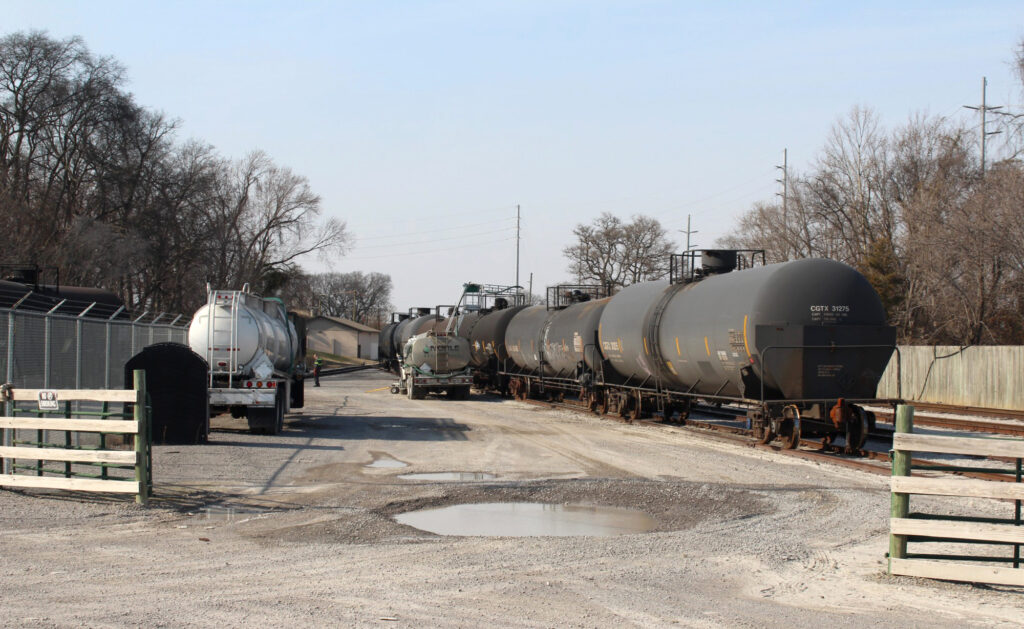
This is real railroading. There is no circus train passing a marching band on a nearby street. There are no saturated primary colors or eye-catching architectural masterpieces. It’s flat black tankers under dull brown trees, gray gravel, and mud puddles. The shot was taken earlier this year in Old Hickory, TN at what appears to be a team track facility a block from the RJ Corman yard. At first glance I thought these were incoming loads. They aren’t. Actually, what’s happening is very common. The tank cas are being loaded with waste automobile oil. The vendor, in this case Noble Oil Services, is an environmental services firm that goes from gas station to gas station collecting their waste products. They then go to the team track facility where an empty tank awaits for them to pump the oil into. The employee in the distance is clad in safety gear and reading his cell phone while the truck is pumping out (A ModelU figure maybe). Are the other tank cars spotted for Noble or another vendor? In examining our approach to the hobby we need to decide what we want from our scenes and how to compose them. Are we going to be a like a cat with a laser pointer in our element selection? i.e. “Hey that’s cool, gimme one of those. Oh, there’s something else that’s cool (and totally unrelated), I want one of those too”. Or, do we want to identify and locate scenes such as this and blend them into a fabric of plausibility. It’s not my railroad. You decide.
One of the driving reasons people engage in model railroading is to be transported, to be taken away to “someplace” in miniature. Where that place is seems to fall into two primary camps. First, you have the largest group of folks that want to go to the realm of pure fantasy, a land where fun, caricature, color saturation, amped up and unusual architecture and the out-of-the ordinary drive the composition. If you’re reading this blog, that’s not you. Sorry, you’re in the other camp, you’re in the minority. You want to go to a place that actually exists, existed at one time, or very well “could” have been. If there is no way in hell the scene on your layout would occupy a spot in real life railroading, you tune out and do so quickly. If I had to pick a single word to describe the effect my readers are after it would be “plausibility”. It doesn’t have to be rivet-to-rivet, inch-inch-by-inch accurate, but it needs to be believable.
If that’s your end game, then the focus becomes how to get there. The starting point is careful study and examination. What is it about a location that makes it what it is? Unlike the larger camp, you’re trying to unearth, nail down, and define “ordinary”. You’re doing the opposite of most and trying to edit out the one in a million element defined by shock value. You’re looking for elements with no shock value. It’s day-to-day, down in the weeds, revenue generating railroading. It’s a world typified by dull browns, charcoal blacks, and a dead flat finish on everything. Weeds not golf courses. Operations that tend to be pretty similar week in and week out. That scrap yard is going to need those loaded gons pulled out every week. It’s not going to switch to Tropicana OJ reefers just because Walthers had them on sale and you like the color orange!
It takes time and patience to define “ordinary”, to define the essence of a real scene. If you can do so there’s a tremendous payoff. If you can hit the target, when you walk into your layout room, you’ll feel transported to the world of real railroading and that’s what you were shooting for in the first place.
Such a great piece Lance. “You’re looking for elements with no shock value.”, love that line. Seems easy, but it’s not. We tend to gloss right over them. Also, they can be hard to model as you don’t want them to be ‘noticed’, but at the same time the make the scene look right. Dead leaves, wind blown branches, twigs, stuff like that sits near the tracks almost unnoticed but if you don’t model it, the scene looks off.
Side note, there is another tanker just left of the tank truck outside the barbed wire fence..
Thanks Ken. I’m not sure what’s to the left. Aerials show a totally fenced in, one track spur.
Another excellent article Lance. Like Ken I really liked the “shock value” line. Easy to get caught up in having to have that eye catching piece on a layout. I’m definitely heading down the less is more path thanks to your insights.
Thanks Roger!
I agree completely with the point of view in this article. Practically everything on my urban industrial railroad is weathered, and I try to use muted colours on structures as best I can. Lots of greys, beiges, and browns. However the grass and weeds are green – too green in fact, and I keep thinking I should go to more burnt or dry looking foliage.
Thanks Jim. Actually, there are plenty of “green” weeds trackside. I’d be inclined to leave what you have as is.